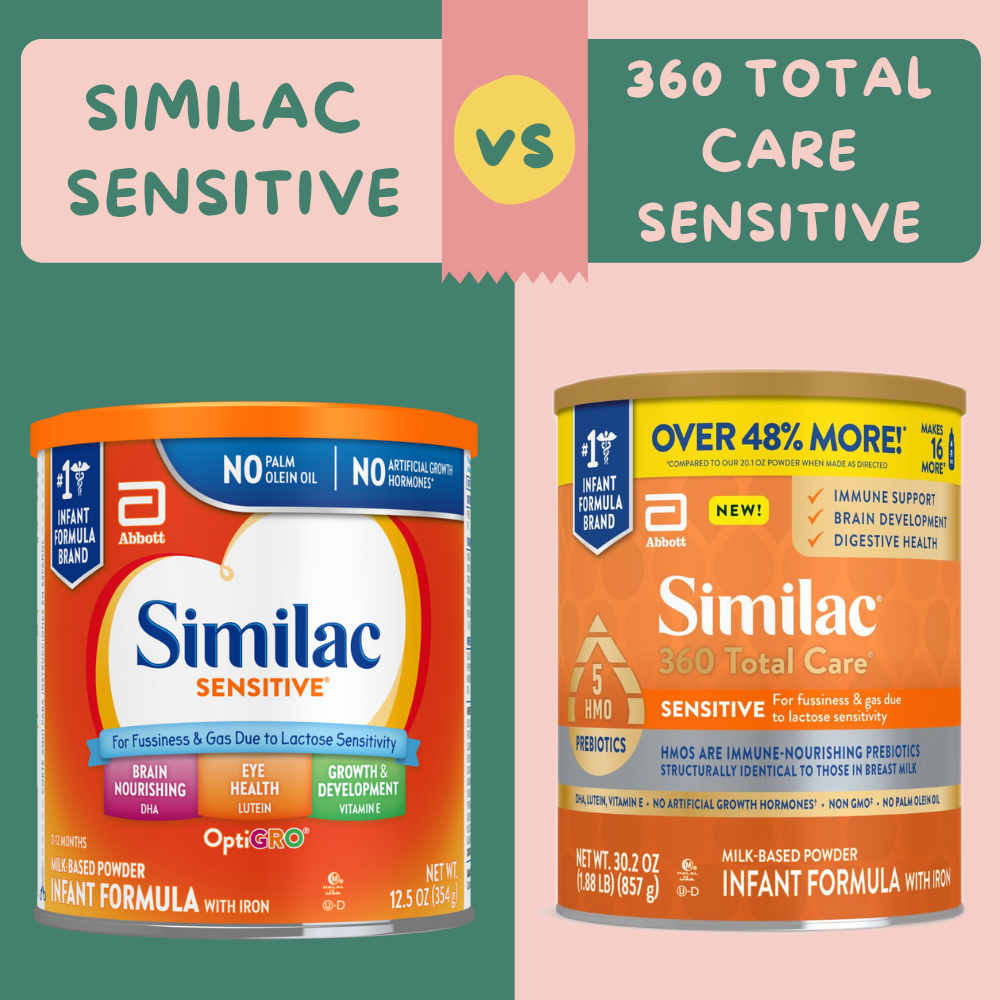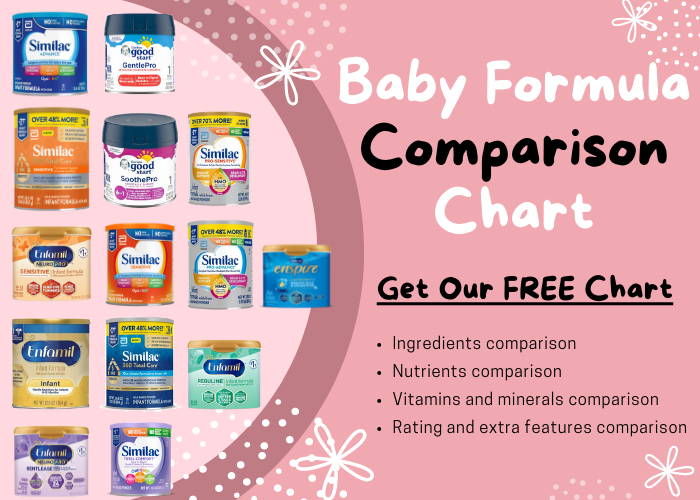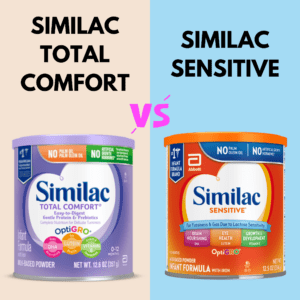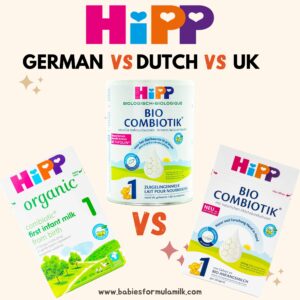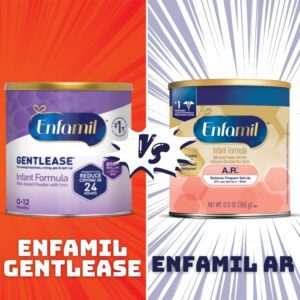Similac Sensitive and 360 Total Care Sensitive are lactose-reduced formulas by 99% and 98% respectively designed for babies who have fussiness and gas due to lactose sensitivity. However, there are some differences to consider:
Similac 360 Total Care Sensitive distinguishes itself as a non-GMO formula fortified with 5 HMO prebiotics, supporting gut health. In contrast, Similac Sensitive lacks a non-GMO label, contains only one prebiotic, is cost-effective, and includes the OptiGro feature for balanced nutrition.

“When you buy something using my links, I may earn a small commission at no additional cost to you. This is a kind of support to me. This website doesn’t accept money for reviews. “
The Best One?
The choice between Similac 360 Total Care Sensitive and Similac Sensitive depends on your baby’s specific needs and priorities. Here’s a breakdown:
GMO Preference:
Similac 360 Total Care Sensitive is the standout option for parents who prioritize non-GMO ingredients. It is explicitly labeled as non-GMO, offering peace of mind to those who wish to avoid genetically modified organisms in their baby’s formula.
Price:
Similac Sensitive comes as a cost-effective choice. This affordability can be a significant advantage for families watching their budget, making it an excellent option for those who want quality without breaking the bank.
Digestive Issues:
Sensitive Tummies and Spit-up: If your baby experiences sensitive tummies or frequently spits up, Similac 360 Total Care Sensitive is the preferred choice. It is specially formulated to minimize spit-up and cater to sensitive digestive systems, offering relief to both parents and infants.
Fussiness and Reflux: On the other hand, if your baby is prone to fussiness and reflux, Similac Sensitive is the top recommendation. It has received positive feedback for effectively soothing fussy babies and reducing reflux symptoms.
Prebiotics:
Comprehensive Digestive Support: Similac 360 Total Care Sensitive takes the lead with its inclusion of five HMO (Human Milk Oligosaccharide) prebiotics. These prebiotics provide extensive support for your baby’s developing digestive system, potentially promoting a healthier gut microbiome.
One Prebiotic: In contrast, Similac Sensitive offers a single prebiotic, which may suffice for some babies but doesn’t provide the same level of digestive support as the five HMO prebiotics in Similac 360 Total Care Sensitive.
Taste and Transition:
If you’re concerned about your baby’s acceptance of the formula’s taste and a smooth transition from breastfeeding to formula, Similac Sensitive is the more suitable choice. Some parents have reported that their babies enjoy the taste of this formula, making feeding a more pleasant experience.
Mom’s Reviews Comparison:
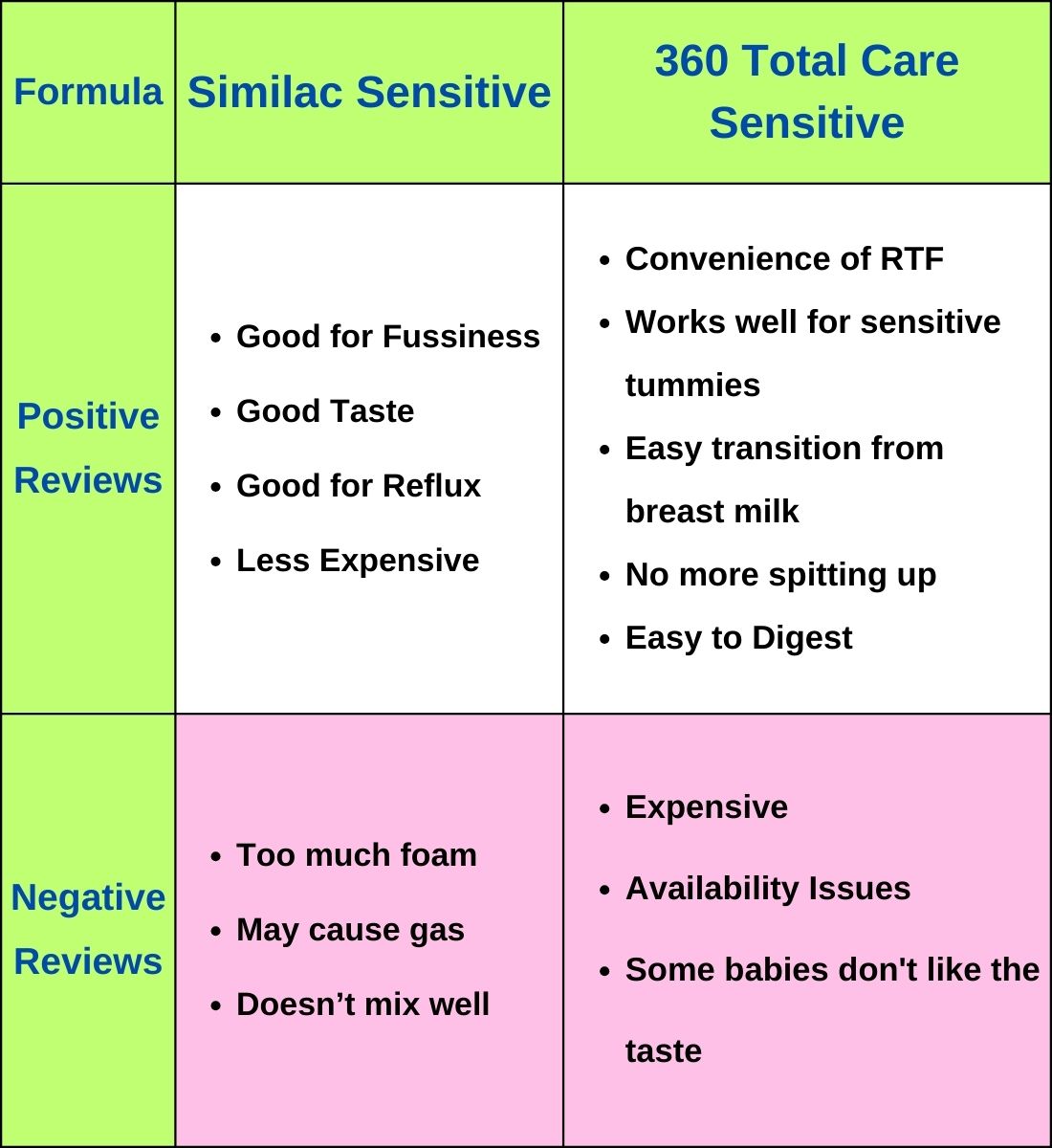
Similac 360 Total Care Sensitive:
Positive Reviews:
- The convenience of Ready-to-Feed: Many parents found the ready-to-feed (8fl oz) format of 360 Total Care Sensitive highly convenient. This is especially valuable when on the go, as it eliminates the need for mixing and measuring, making feedings quick and easy.
- Works Well for Sensitive Tummies: Several reviewers reported that this formula worked well for babies with sensitive stomachs. It was gentle on their digestion, resulting in fewer instances of spitting up and discomfort. This aspect is especially important for parents seeking a formula suitable for sensitive infants.
- Easy Transition from Breast Milk: Some parents mentioned that Similac 360 Total Care Sensitive was a good choice for transitioning from breastfeeding to formula feeding. It’s gentle enough for babies’ stomachs, making it a suitable choice for mixed feeding or exclusively formula-fed babies.
- No More Spitting Up: A common positive point was that this formula helped reduce instances of spitting up. Babies who previously had issues with spitting up experienced relief when using this formula.
- Positive Impact on Baby’s Digestion: Many parents noted that the formula had a positive impact on their baby’s digestion. It led to less gas, more regular bowel movements, and overall improved digestive comfort for their infants.
Negative Reviews:
- High Price: One of the most frequently mentioned negative aspects was the high price of the Similac formula. Some parents felt that the cost was steep, especially considering that infants may consume multiple bottles per day. This price concern is relevant for budget-conscious families.
- Availability Issues: Several reviewers encountered availability issues. These issues were often attributed to the formula shortages occurring during the review period. Limited availability can be a significant challenge for parents who rely on specific formulas to meet their baby’s dietary needs.
- Some Babies Don’t Like the Taste: While most babies seemed to tolerate this formula well, a few parents reported that their infants didn’t like the taste. Babies can have varying preferences, and in some cases, it may take time for a baby to adjust to a new formula.
Related: Similac 360 Total Care Vs 360 Total Care Sensitive
Similac Sensitive:
Positive Reviews:
- Good for Fussiness: Many mothers have found Similac Sensitive to be highly effective in soothing their infants who tend to be fussy due to sensitive stomachs.
- Good Taste: Some parents have noted that their babies genuinely like the taste of Similac Sensitive. This is significant because babies are often finicky eaters, and a formula that they enjoy can make feeding a more enjoyable experience for both the child and the parents.
- Good for Reflux: Similac Sensitive has garnered positive feedback for its ability to mitigate symptoms of reflux in certain infants. Reflux can be a source of discomfort for babies, and this formula seems to help in alleviating these symptoms.
- Budget-Friendly: For families on a budget, Similac Sensitive is seen as a cost-effective option to address their baby’s digestive issues. This affordability is especially beneficial, given that raising a child can be expensive.
Negative Reviews:
- Mixing Challenges: Some parents have encountered difficulties when mixing Similac Sensitive. It tends to become too foamy, making it less convenient to prepare. One solution to this issue is to use Dr. Brown bottles for mixing because they tend to blend it more effectively, reducing the formation of excessive bubbles, especially if you gently swirl the bottle.
- Potential Gas: There have been reports from some parents suggesting that Similac Sensitive might contribute to gas in certain babies. These infants may require a more gentle and sensitive formula to alleviate gas-related discomfort.
Ingredients Comparison:
Protein Source:
- Both formulas utilize Milk Protein Isolate as the primary protein source. Milk Protein Isolate is a high-quality protein derived from cow’s milk. It contains a balanced proportion of essential amino acids necessary for a growing baby’s development.
Whey to Casein Ratio:
- The whey-to-casein ratio plays a crucial role in the digestion and absorption of these formulas. In 360 Total Care Sensitive, the ratio is 20% whey to 80% casein, while Similac Sensitive has a slightly different ratio of 18% whey to 82% casein. Whey protein is easier to digest, and absorb quickly, which can reduce the likelihood of digestive discomfort in some babies. Casein protein, on the other hand, takes longer to digest, providing a slower release of nutrients. The difference in these ratios may affect how satisfied your baby feels after feeding and their overall digestion.
Carbohydrate Source:
- 360 Total Care Sensitive contains 2% lactose while the remaining carbohydrates are sourced from corn syrup and sugar.
- Similac Sensitive contains 1% lactose but also includes other carbohydrate sources such as corn syrup, sugar. These additional carbohydrates may influence the taste and texture of the formula. Parents often select formulas based on their baby’s tolerance and preference.
Related: Similac Sensitive Vs. Similac Total Comfort
Fat Source:
- Both formulas share similar primary fat sources, including High Oleic Safflower Oil, Soy Oil, and Coconut Oil. These fats provide essential fatty acids necessary for an infant’s development.
DHA/ARA:
- Both formulas are fortified with DHA and ARA, essential fatty acids for brain and eye development. These nutrients are typically sourced from Crypthecodinium cohnii oil and Mortierella alpina oil, which are naturally occurring microalgae and fungi.
Extra Features:
- Similac Sensitive includes OptiGro, which is a blend of DHA, Lutein, and Vitamin E. DHA supports brain development, Lutein supports eye health, and Vitamin E provides essential antioxidant protection. These extra components are designed to enhance overall infant development.
- 360 Total Care Sensitive has 5 HMO prebiotics as an extra feature.
Prebiotics:
- 360 Total Care Sensitive boasts a rich array of prebiotics, including 2′-FL HMO, Lacto-N-Tetraose, 3-Fucosyllactose, 6′-Sialyllactose, and 3′-Sialyllactose. These prebiotics provide nourishment for beneficial gut bacteria, promoting a balanced gut microbiome and supporting digestion.
- Similac Sensitive contains Short-chain Fructooligosaccharides (FOS), which are a type of prebiotic known to enhance gut health. While both formulas support digestive wellness, the variety and diversity of prebiotics can differ, potentially impacting the development of the baby’s gut microbiome.
GMO-Free:
- 360 Total Care Sensitive is explicitly labeled as GMO-Free, assuring parents that it does not contain genetically modified ingredients. This can be important for those seeking a formula with minimal processing and potential allergens.
- While Similac Sensitive is not labeled as GMO-Free, leading infant formula brands often adhere to rigorous quality and safety standards, ensuring the use of non-GMO ingredients.
Generic Brands:
- Both formulas offer a choice of seven generic or store-brand alternatives. These alternatives are formulated to provide similar nutritional benefits to the brand-name product but may come at a lower cost. This can be particularly appealing to budget-conscious parents who want to provide high-quality nutrition for their infants without breaking the bank. Read Best 7 Generic Brands For Similac Sensitive.
Nutrients Comparison:

Macronutrients:
In terms of protein, both formulas contain 2.1 grams per 100 calories, providing a balanced source of this vital nutrient that’s crucial for building and repairing tissues in the body.
When it comes to fat, both Similac Sensitive and 360 Total Care Sensitive provide 5.4 grams per 100 calories, ensuring an adequate fat supply for infant growth, energy, and the absorption of fat-soluble vitamins.
For carbohydrates, both formulas contain 10.9 grams per 100 calories, with similar sources that include corn syrup, sugar, and lactose (in small amounts), ensuring that your baby receives the necessary carbohydrate energy.
Vitamins:
Both Similac Sensitive and 360 Total Care Sensitive closely match in terms of vitamin content including vitamins A, D, E, K, C, and B vitamins.
Other Nutrients:
Both formulas provide 24 mg of Choline per 100 calories, which is vital for brain and nervous system development in infants.
Also, they are fortified with 24 mg of Inositol per 100 calories, which plays a crucial role in cell signaling and structure. The average amount in breast milk is 22 mg/100 Cal.
Related: Enfamil Gentlease vs. Similac Sensitive
Minerals:
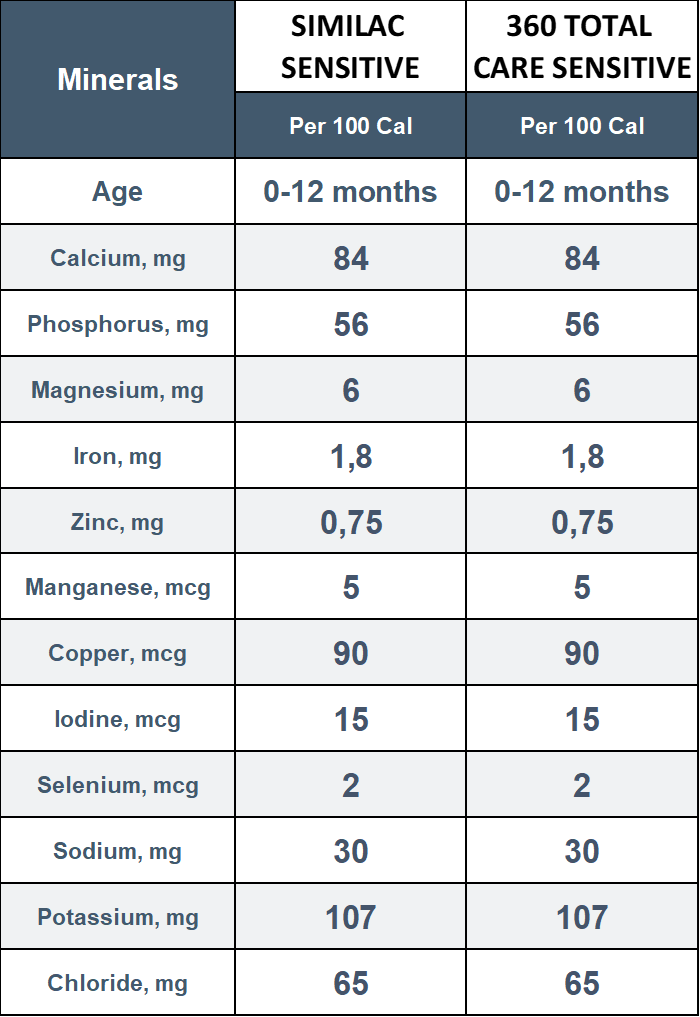
In conclusion, Similac Sensitive and 360 Total Care Sensitive closely match in terms of mineral content per 100 calories including calcium, phosphorus, iron, zinc, and potassium. These mineral components are essential for the healthy growth and development of infants.
Price Comparison:
| Similac 360 Total Care Sensitive | Similac Sensitive |
|---|---|
| 20.1 oz $35.18 1.75 /oz Buy 20.1 oz 30.2 oz $47.98 1.59 /oz Buy 30.2 oz 2-fl-oz $1.25 62.41 ¢/fl oz Buy 2 fl oz 8-fl-oz $2.78 34.74 ¢/fl oz Buy 8 fl oz 32-fl-oz $10.92 34.12 ¢/fl oz Buy 32 fl oz | 12.5 oz 17.94 $ 1.50/oz Buy 12.5 oz 34.9 oz 37.92 $ 1.09 /oz Buy 34.9 oz 32 fl oz 7.82 $ 24.4 ¢/fl oz Buy RTF |
| 4.8 of 5.0 590 reviews | 4.6 of 5.0 2275 reviews |
While Similac Sensitive offers a more cost-effective option in the larger 34.9 oz container with a unit cost of $1.09 per ounce, Similac 360 Total Care Sensitive is priced slightly higher per ounce. However, this last offers multiple forms and sizes, the 2fl oz and 8 fl oz are perfect for on-the-go and traveling.
Moreover, its higher rating suggests it might be favored by some parents. Additionally, both formulas are available in ready-to-feed formats for added convenience.
Can You Switch Between Similac Sensitive and 360 Total Care Sensitive?
Yes, you can switch between Similac Sensitive and Similac 360 Total Care Sensitive if needed. Parents may consider switching based on their baby’s nutritional needs or sensitivities. It’s important to follow guidelines for a smooth transition and monitor your baby’s response to the new formula.
Related: Similac 360 Total Care Sensitive Vs Enfamil Gentlease
How to Switch Between Similac Sensitive and 360 Total Care Sensitive?
Switching between infant formulas like Similac Sensitive and Similac 360 Total Care Sensitive is better done with care and guidance. Here are some considerations and steps to keep in mind when making a switch:
- Consult Your Pediatrician: Before making any changes to your baby’s diet, it’s crucial to consult your pediatrician or healthcare provider. They can provide personalized recommendations based on your baby’s specific needs and any existing health concerns.
- Gradual Transition: If your pediatrician recommends switching formulas, it’s usually advised to do so gradually. Start by mixing a small amount of the new formula with the old formula. For example, use 25% of the new formula and 75% of the old formula for a few days. Then, gradually increase the proportion of the new formula over a week or longer until your baby has fully transitioned to the new formula.
- Monitor for Tolerance: Pay close attention to how your baby responds to the new formula. Look for any signs of digestive discomfort, allergies, or sensitivities. If your baby experiences any adverse reactions, consult your pediatrician to discuss potential solutions.
By following these guidelines and closely collaborating with your pediatrician, you can safely and effectively switch between Similac Sensitive and Similac 360 Total Care Sensitive if it’s determined to be in the best interest of your baby’s health and well-being. Always prioritize your baby’s comfort and nutritional needs throughout the transition.

